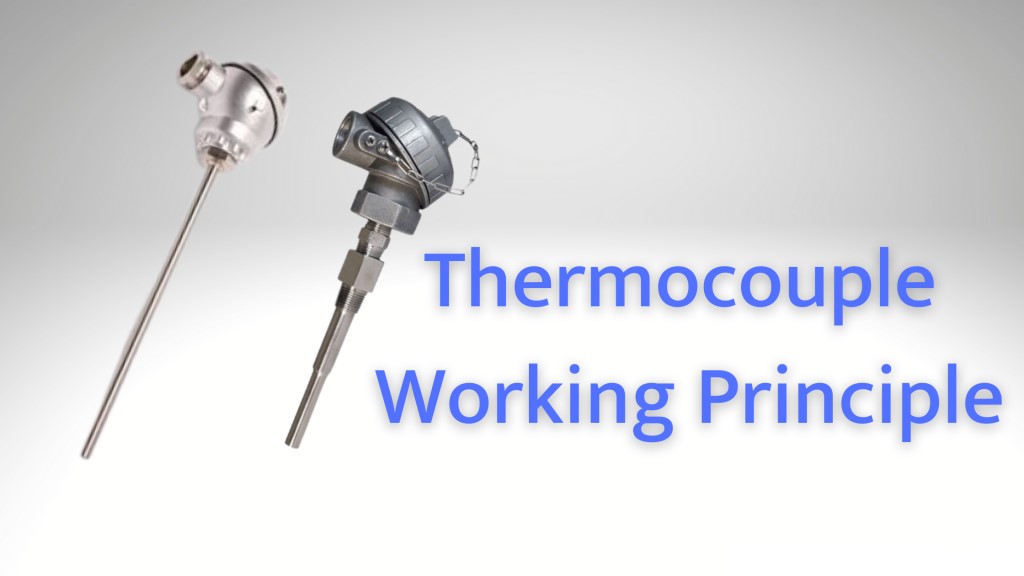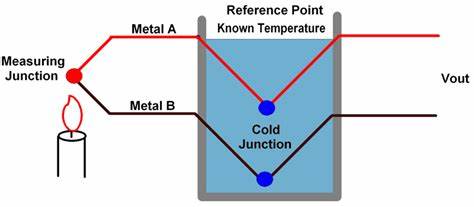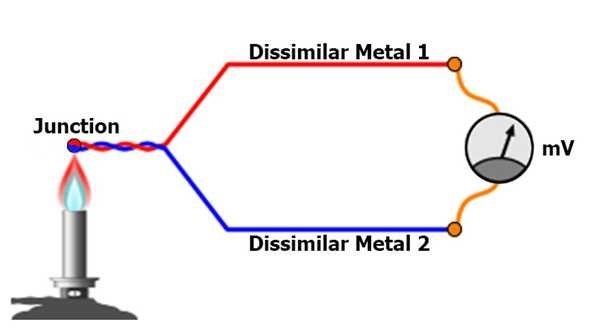To understand the working principle of thermocouple, we must first understand its definition:
The thermocouple is a type of temperature sensor that measures temperature at a single spot in the form of an EMF or an electric current. Because the quantity of EMF produced in the device is very small (millivolts), highly sensitive instruments must be used to calculate the EMF produced in the circuit. These are active transducers since they operate on the energy conversion concept. Their operation does not need the use of any form of power. These are essential temperature sensors that measure temperature as EMF. Certain metal combinations must be utilized to construct a thermocouple pair. These metal combinations are chosen in such a way that a linear rise in EMF is created as the temperature of the circuit rises.
This article outlines the definition, and the working principle of thermocouple. So, do not miss this article at Linquip.
Working Principle of Thermocouple
In this part, we go through the working principle of thermocouple and the instruments required for the operation. So, let us begin with the subject:
When two metals with different work functions come together, a voltage is created at the junction. This voltage is proportional to the temperature, and this junction is referred to as a “thermocouple.”
The thermocouple operates on three effects including the “Seebeck effect”, the “Peltier effect”, and the “Thomson effect”. The issue now is, what are these effects?
Let’s discuss in detail below:
1) Seebeck effect:
A physicist named “Thomas Seebeck” discovered in 1821 that when two distinct metal wires are linked in a circuit at both ends of a junction, the temperature applied to the junction equals the current flowing through the circuit. It is referred to as the electromagnetic field (EMF). The energy produced by this circuit is referred to as the Seebeck effect. The quantity of induced EMF varies with metal combination and is related to the temperature differential between the junctions. This is the fundamental functioning principle of a thermocouple. In a nutshell, it is a phenomenon in which the temperature differential between two metals causes potential differences between them.
2) Peltier effect:
The Peltier effect is an important part of the thermocouple’s operation. This effect is the polar opposite of the See beck effect. The Peltier effect demonstrates that by introducing a potential difference between two distinct types of conductors, a temperature differential may be generated. The thermocouple circuit is made up of two metals that are linked together to produce two temperature junctions. The difference in temperatures between the circuit’s two junctions generates a Peltier EMF. The total EMF within the circuit may be calculated using the junction temperature and the characteristics of the metals employed in the circuit. A body with an unknown temperature is attached to one of the circuit’s connections, known as the hot junction. Another body with a known temperature is linked to the other connection, which is known as the cold or reference junction. To directly measure the voltage or current output from the thermocouple circuit, a voltmeter is attached to the thermocouple circuit.
Read More on Linquip
- What is a Thermocouple & How Does It Work?
- Thermocouple Types: A Complete Comparison Between Them
- Thermocouple for Water Heater: How does it Work?
3) Thomson effect:
As the temperature of the junction varies, so does the voltage, which may be monitored using an electronic controller’s input circuits. The voltage output is related to the temperature difference between the junction and the free ends. This is known as the Thompson effect. According to this effect, when two dissimilar metals are linked together to form two junctions, a potential occurs inside the circuit owing to a temperature gradient throughout the whole length of the conductors within the circuit. In most situations, the EMF predicted by the Thomson effect is relatively tiny and may be ignored by carefully selecting metals.
Summary
In today’s post, we looked at the working principle of thermocouple along with the techniques it operates.
We defined a thermocouple as a temperature sensor that measures temperature in terms of voltage based on the temperature differential between two ends of a metal pair. It is one of the most often used temperature sensors. Then we mentioned that the working principle of thermocouple is based on three primary techniques or effects, which are as follows: Seebeck Effect, Peltier Effect, and the Thompson Effect. The See back effect happens when two distinct metals come into contact with one other. When heat is applied to any of the metals, electrons begin to move from heated metal to cold metal.
As a result, a direct current is generated in the circuit. The Seebeck effect is the converse of the Peltier effect. The Peltier effect states that by introducing a potential difference between two conductors, a temperature differential may be generated. When two dissimilar metals are joined, a tiny voltage known as a thermo-junction voltage is produced at the junction. Then the third effect: according to the Thompson effect, when two different metals link together and form two junctions, the voltage induces the entire length of the conductor due to the temperature difference. The temperature gradient is a physical term that describes the direction and rate of temperature change at a certain place.
Thanks for reading about the ” working principle of thermocouple “. If you need to gain more information or you have another variety of knowledge about the working principle of thermocouple, feel free to share. Our experts are happy and looking forward to receive your precious comments. Don’t forget to first register at Linquip.
Buy Equipment or Ask for a Service
By using Linquip RFQ Service, you can expect to receive quotations from various suppliers across multiple industries and regions.
Click Here to Request a Quotation From Suppliers and Service Providers
Read More on Linquip
- The Best USA Thermocouple Manufacturers
- Thermocouple Types: A Complete Comparison Between Them
- What is a Thermocouple & How Does It Work?
- Thermocouple for Water Heater: How does it Work?
- Thermistor vs Thermocouple: Complete Comparison & Practical Selection Guide
- Thermocouple vs. Thermopile: A Complete Comparison & Advantages of Each Type
- Difference Between Thermopile and Thermocouple





